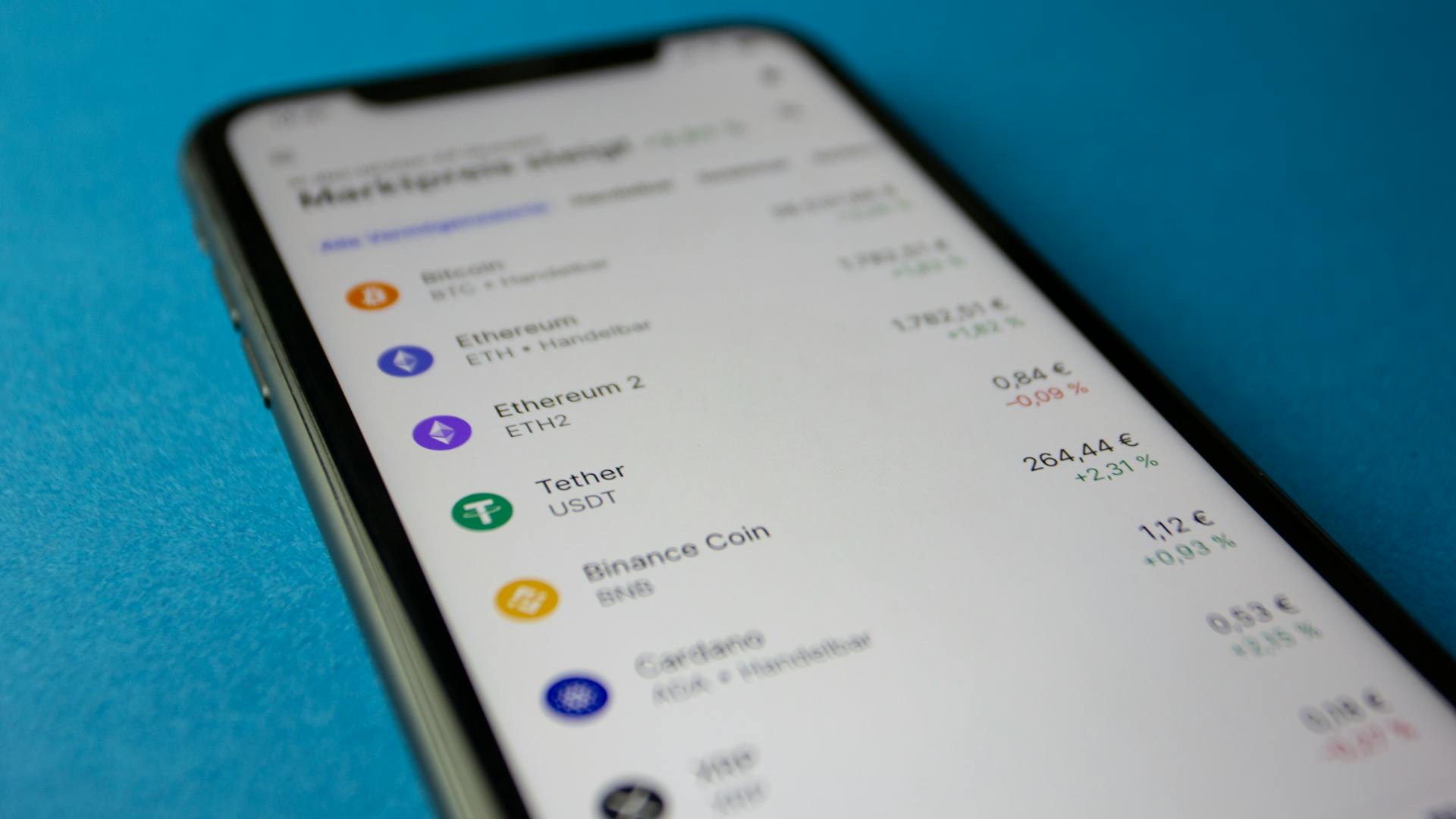
Cardano Smart Contracts are designed to be self-executing, with the terms of the contract written directly into lines of code. This allows for a high degree of automation and efficiency.
Cardano's smart contracts are built on top of the Haskell programming language, which is known for its strong type system and rigorous mathematical foundations. This provides a high level of security and predictability.
The Cardano platform uses a proof-of-stake (PoS) consensus algorithm, which is more energy-efficient and scalable than traditional proof-of-work (PoW) algorithms. This allows for faster transaction processing and lower fees.
Cardano's smart contracts are also designed to be highly interoperable, allowing for seamless interactions between different blockchain networks and systems.
A different take: Co-founder Animoca Brands - Yat Siu
What Are Smart Contracts?
Smart contracts are digital agreements defined in code that automate and enforce the terms of a contract without the need for intermediaries.
On the Cardano blockchain, these contracts are stored and distributed across a decentralised network, allowing for secure and transparent transactions.
The rules of a smart contract can't be modified once it's been created, ensuring that the terms of the contract are always followed.
This means that the state of a contract can only be updated in a way that follows the rules defined in that contract, providing a high level of security and reliability.
The code of a smart contract is compiled and stored on the Cardano blockchain, making it impossible to decompile it back into its original source code.
Creating and Developing Smart Contracts
Developing a Cardano Plutus smart contract involves several key stages, starting with understanding the fundamentals of Plutus and Haskell, including Cardano Plutus V3. This requires learning functional programming concepts and Haskell syntax.
You'll also need to specify the goal of your smart contract, clearly outlining its purpose and functionality. This involves identifying inputs and outputs, determining the data that will be processed, and the results generated.
To set up the development environment, you'll need to install necessary tools, such as the Cardano CLI and Plutus Core compiler, and configure your environment with appropriate libraries and dependencies.
Here are the 8 steps to follow:
- Understanding Plutus and Haskell
- Specifying the goal
- Setting up the development environment
- Writing the Plutus script
- Compiling to Plutus Core
- Testing and debugging
- Deploying to Cardano Network
- Monitoring and maintaining
Steps for Developing
Developing a smart contract requires a clear understanding of the underlying technology and programming languages involved. To get started, you need to learn the fundamentals of functional programming concepts and Haskell syntax, including Cardano Plutus V3.
It's essential to specify the goal of your smart contract, outlining its purpose and functionality. This will help you identify the inputs and outputs, and define the logic that governs the contract's behavior.
To set up your development environment, you'll need to install necessary tools such as the Cardano CLI, Plutus Core compiler, and other required software. You'll also need to configure your environment with appropriate libraries and dependencies.
Writing the smart contract's logic involves creating a Plutus script using Haskell, defining data types to represent the contract's inputs and outputs, and implementing contract functions to handle different contract states and actions.
Compiling your Plutus script into Plutus Core is a crucial step, as this is the executable format for the Cardano blockchain.
Here are the key stages in developing a smart contract:
- Understanding Plutus and Haskell
- Specifying the goal and identifying inputs and outputs
- Defining the logic and setting up the development environment
- Creating a Plutus script and defining data types
- Compiling to Plutus Core
- Testing and debugging the contract
- Deploying the contract to the Cardano network
- Monitoring and maintaining the contract
Remember to prioritize security, optimize your code for efficiency and performance, and create clear documentation for the smart contract to aid understanding and maintenance.
Marlowe
Marlowe is a domain-specific language (DSL) that allows users to build blockchain apps, particularly those focused on financial transactions.
Users can tap into Marlowe's advantages, such as greater safety, assurance of certainty, and assurance of termination.
One key benefit of Marlowe is its assurance of behavior correctness, which means developers can have confidence in how their code will perform.
Marlowe's design ensures several qualities, including greater safety, assurance of certainty, assurance of termination, and better assurance of behavior correctness.
These qualities make Marlowe an attractive choice for building blockchain apps, especially those involving financial transactions.
Explore further: Shop Now Pay Later Apps
Programming Languages
Cardano supports the development and deployment of smart contracts using multiple languages, including Aiken, Marlowe, opshin, Plutus, and plu-ts.
Aiken is a language and toolchain specifically designed for on-chain validator scripts, prioritizing developer experience. It's a great choice for those who want to create efficient and user-friendly smart contracts.
Marlowe is a domain-specific language that's perfect for financial contracts. It's a specialized language that helps you create contracts with precision and accuracy.
Haskell is the primary language used for Plutus and also regulates Marlowe. It's a powerful language that produces high-assurance codes, which are essential for reliable and accurate smart contracts.
Here's a brief overview of the languages supported by Cardano:
- Aiken: for on-chain validator scripts only
- Marlowe: a domain-specific language for financial contracts
- opshin: a programming language for generic Smart Contracts based on Python
- Plutus: a platform for writing full applications that interact with the Cardano blockchain
- plu-ts: a Typescript-embedded smart contract programming language and transaction creation library
Cardano's support for multiple languages makes it a versatile platform for smart contract development.
Architecture and Workflow
Cardano's architecture is divided into two distinct layers: CCL (Cardano Computation Layer) and CSL (Cardano Settlement Layer). This separation of tasks allows for more efficient operations.
The CCL is used to create ADA smart contracts, while the CSL handles ADA transfers. In contrast, Ethereum handles both smart contract and ETH transactions on the same layer, resulting in higher costs and congestion.
Cardano's smart contract workflow involves two main components: on-chain and off-chain. The on-chain component is a validator script that enforces the rules of the contract, while the off-chain component is a script that generates a transaction to move assets according to the contract's rules.
If this caught your attention, see: Will Paying off Delinquent Debt Improve My Credit
Here's a breakdown of the basic contract workflow:
- Create a validator-script that compares the datum in the UTXO being moved from the contract's address to the hash of the redeemer being used in the transaction moving it.
- Create a script that generates a transaction moving assets to the address of the validator-script, specifying the datum to be stored on-chain.
- Sign and submit the transaction to a Cardano node.
- The only way to move the locked assets is to generate a transaction with the correct redeemer.
For more complex contracts, the on-chain component must encode logic for multiple actions, such as moving the contract forward or unlocking the UTXO. The off-chain component must be able to decode the datum to determine the current state of the contract and generate the correct transaction.
Recommended read: Bnb Smart Chain Bep20 Bitpay
Architecture
The architecture of a network can greatly impact its efficiency and cost-effectiveness.
The Cardano network is separated into two distinct layers: CCL and CSL.
This separation of tasks allows for more effective running of operations on both tiers.
Ethereum, on the other hand, handles both smart contract and ETH transactions on the same layer, resulting in greater costs and congestion.
Basic Workflow
The basic workflow for creating a contract on Cardano is a straightforward process. You create a validator-script that compares the datum in the UTXO being moved from the contract's address to the hash of the redeemer being used in the transaction moving it.
This on-chain component is the core of your contract, and it's what ensures that only authorized transactions can move the locked ada. You also create an off-chain script that generates a transaction moving some amount of ada or other assets to the address of the validator-script.
When generating the transaction, you specify the datum to be Hash("secret"), making sure that only the hashsum of the word "secret" gets stored on-chain. This is a crucial step, as it's what locks the ada in the contract.
You sign and submit the transaction to a Cardano node either directly or via one of many available APIs, such as Blockfrost or Dandelion. The ada you sent to the contract is now locked by your validator, and the only way to move it is to generate a transaction with the word 'secret' as a redeemer.
Here's a step-by-step breakdown of the basic workflow:
- Create a validator-script that compares the datum in the UTXO being moved from the contract's address to the hash of the redeemer being used in the transaction moving it.
- Create an off-chain script that generates a transaction moving some amount of ada or other assets to the address of the validator-script.
- Sign and submit the transaction to a Cardano node either directly or via one of many available APIs.
- Generate a transaction with the word 'secret' as a redeemer to unlock the ada.
Key Features and Advantages
Cardano smart contracts offer several key features and advantages that make them an attractive option for developers and users alike.
Plutus, a functional programming paradigm, is the backbone of Cardano smart contracts. It's based on Haskell, a purely functional programming language that allows for easier formal verification, reducing the risk of vulnerabilities and exploits.
The separation of on-chain and off-chain code in Plutus enables more efficient usage of blockchain resources, bringing improved scalability. This is a major advantage over traditional smart contract platforms.
Cardano's native token functionality empowers users to build custom tokens directly on the blockchain without smart contracts, improving efficiency and minimizing complexity.
Plutus provides assurance that the same smart contract will produce the same output for any given input, regardless of the environment in which it is executed. This consistency is crucial for a network.
Formal verification is a key aspect of Plutus, allowing for mathematically proving the correctness of smart contracts. This enhances the security and reliability of the code.
Here are some benefits of Cardano smart contracts:
- The smart contract integration does not need middlemen to carry out or keep the contracts, expediting the process.
- The smart contracts lay on a decentralized network, and are free from tampering.
- The data stored on a decentralized network gets stored permanently, along with their backups.
- They provide unparalleled security and sustainability to decentralized applications, systems, and societies.
- It is created based on a research-driven and scientific philosophy; it is a more transparent and sustainable foundation for individuals to transact and exchange, systems to govern, and enterprises to grow.
- Its users can access the information whenever they want. They can enjoy data ownership and have complete control over their data, and can send it across the blockchain at any time.
Real-World Applications and Cases
Cardano smart contracts are revolutionizing the way we think about finance, identity, and supply chain management. With the power of Plutus, developers can create complex financial products, lending platforms, and decentralized exchanges with enhanced security and efficiency.
Decentralized Finance (DeFi) is one area where Cardano smart contracts are making a significant impact. They enable the creation of unique digital assets, lending platforms, and decentralized exchanges.
Immutable and verifiable smart contracts ensure better transparency and traceability in supply chain operations. This is a game-changer for industries that require secure and reliable tracking of goods.
One of the most notable examples of a real-world application of Cardano smart contracts is Marlowe. It's a custom domain-specific language (DSL) designed to make it easy for end users to create their own financial contracts.
Marlowe's off-chain component takes care of creating transactions that include the contract DSL in the transaction together with the current state. The validator makes sure that all state transitions are valid according to the custom Marlowe logic.
For more insights, see: How to Create a Smart Contract
Here are some of the key benefits of Cardano smart contracts in real-world applications:
- Decentralized Finance (DeFi)
- Immutable and verifiable smart contracts
- Secure and privacy-preserving identity solutions
- Decentralized autonomous organizations (DAOs) and voting systems
- Supply chain operations with enhanced transparency and traceability
Cardano smart contracts have the potential to revolutionize the way we think about digital identity verification. By building secure and privacy-preserving identity solutions, we can create a more trustworthy and secure digital world.
Curious to learn more? Check out: Chamber of Digital Commerce
Technical Overview
Smart contracts on Cardano are actually quite simple constructs based on validator-scripts that you create to enforce specific rules when a transaction is made. These scripts are just a set of logic and rules that the Cardano nodes will follow when they see a transaction attempting to move a UTXO locked inside the script's address.
The validator scripts have access to read the transaction context and datum of the locked UTXO being moved, which allows you to build some very complex contracts. For example, Marlowe is a good example of this technique used in practice.
The validator scripts are passed three pieces of information as arguments: datum, redeemer, and context. Datum is a piece of data attached to the output that the script is locking, typically used to carry state.
Here's an interesting read: Best Blockchain Validator
The redeemer is a piece of data attached to the spending input, used to provide an input to the script from the spender. This can be used to verify that the output UTXO datum is set to the same result as what the output UTXO datum is set to.
Context is a piece of data that represents information about the spending transaction, used to make assertions about the way the output is being sent. This can include things like "Bob signed it".
Here are some examples of what information is contained in the context:
Oracles and Verification
Oracles are being developed for the entire Cardano blockchain, and users in Marlowe on Cardano will have access to them. They're designed to provide accurate and reliable data to smart contracts, ensuring that transactions are secure and trustworthy.
The "Kraken" Oracle position is a special role that makes judgments, and its decisions are modeled as Oracles. This allows for more complex and dynamic smart contracts that can adapt to changing circumstances.
Cardano Oracles are available to users on both Marlowe and Cardano ADA smart contracts, enabling seamless integration and use across the platform.
Oracles
Oracles are being developed for the entire Cardano blockchain, making them available to users in Marlowe on Cardano. Cardano Oracles are designed to be used throughout the Cardano blockchain and are available to users on both Marlowe and Cardano ADA smart contracts.
The judgments made by a participant in an exclusive Oracle position known as “Kraken” are modeled as Oracles. This position is used to provide real-time data to smart contracts.
In the playground simulation, a choice will be pre-filled with the current value of the direct ADA/USD conversion rate based on data from Cryptowatch if a contract’s role is “Kraken” and that role makes an option like “dir-adausd.” By substituting the prefix inv- for the prefix inv-, it is also feasible to obtain the inverse rates for the currency combinations indicated.
The timeout contingency will stay in effect, guaranteeing that the deal is closed as soon as the timeout and the slot number are reached.
You might like: Ethereum Data Dashboard
Verification of Credentials
Verification of credentials is a crucial process that ensures the authenticity of identities and credentials. Cardano's Atala Prism, Atala Scan, and Atala Trace are designed to support this process.
Atala Prism is an identity management tool that grants access to specific services. It's like having a digital key that unlocks certain doors, but only for authorized individuals.
Atala Scan and Atala Trace are used to track a product's progress through a supply chain. This helps ensure that the product is genuine and hasn't been tampered with during transit.
Cardano is also working with a university to verify credentials more quickly and affordably using their ADA smart contracts. This is a game-changer for educational institutions looking to streamline their verification processes.
For more insights, see: How to Process Credit Card Payments with Merchant Id
Frequently Asked Questions
How to deploy a smart contract on Cardano?
To deploy a smart contract on Cardano, you'll need to pay a fee in ADA to the network. This fee helps prevent network spam and ensures legitimate contracts are deployed.
What language are Cardano smart contracts written in?
Cardano smart contracts are written in Haskell, a programming language specifically used for smart contract creation. Haskell is also used for Marlowe, a domain-specific language for financial smart contracts.
Sources
- https://ideausher.com/blog/how-to-create-cardano-smart-contracts/
- https://www.antiersolutions.com/cardano-plutus-smart-contract-a-detailed-discussion/
- https://developers.cardano.org/docs/smart-contracts/
- https://imaginovation.net/blog/cardano-smart-contracts/
- https://cryptoslate.com/cardano-deploys-first-zero-knowledge-smart-contract-expanding-blockchain-capabilities/
Featured Images: pexels.com


